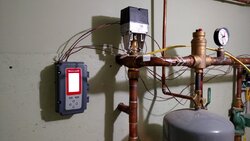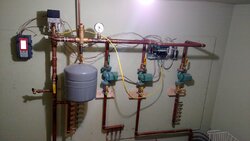hello i have a northern leader indoor wood boiler. it is a smaller of the three models they made. i'm having a hard time finding people who have the same or similar set up. the problem is i'm not heating up the square footage (approx 2200) as well as i'd like. i have 2" foam around and under the 5" slab. 1/2" pex 7 loops total. two zones. primary loop is 1 1/4" copper. i have a commercial 1 1/4" mixing valve. the problem i'm running into is when the pumps kick on it's pulling all the heat out of the stove. i basically have to run the wood stove at wide open with the ash pan door open. it does not have a blower as a damper it just has a mechanical knob with a chain that raises and lowers the draft door. i was wondering if i should be running the pumps non stop (which i have) or run the stove at lets say 180 degrees and 165 as the shut off(which i have and by the time the return water is warm the boiler is at 165). not sure if adding more volume with a storage tank would help or if i need a bigger indoor boiler or if i just need to go with an outdoor stove.
i'm also having a problem with the mixing valve. it's a honeywell globe with an electric accuator and a honeywell stand alone electric control box. when the pumps kick on the plunger on the mixing valve is in the wide open position because the control box is calling for heat because the pumps haven't been moving water for lets say 15 minutes. so the pumps kick on and the stove emptys 180 degree water until the sensor(which is strapped to the outside of the copper pipe right after the mixing valve) gets warm enough to have the actuator throttle back the hot and mix it with the return to get the desired 130 or whatever. i will be ordering an emmersable sensor that actually goes in the hot line right after the mixing valve. i'm hoping that will make the stand alone controller react faster.
any help or insight would be greatful
i'm also having a problem with the mixing valve. it's a honeywell globe with an electric accuator and a honeywell stand alone electric control box. when the pumps kick on the plunger on the mixing valve is in the wide open position because the control box is calling for heat because the pumps haven't been moving water for lets say 15 minutes. so the pumps kick on and the stove emptys 180 degree water until the sensor(which is strapped to the outside of the copper pipe right after the mixing valve) gets warm enough to have the actuator throttle back the hot and mix it with the return to get the desired 130 or whatever. i will be ordering an emmersable sensor that actually goes in the hot line right after the mixing valve. i'm hoping that will make the stand alone controller react faster.
any help or insight would be greatful



